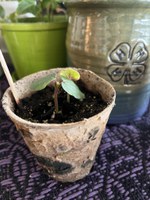Dakota Gardener: Giving okra a go
(Click an image below to view a high-resolution image that can be downloaded)
By Carrie Knutson, Horticulture agent
NDSU Extension – Grand Forks County
I am growing a mystery vegetable for my school garden programs. Spoiler alert - the plant is okra. I am putting into practice what I preach, trying something new in the garden every year. I have not grown okra. Honestly, I am not sure if I have even tasted okra. Growing okra will be a gardening and culinary experience for me.
Okra is in the Malvaceae family, the same family as hibiscus and hollyhock. Depending on your preferences, the flowers can provide ornamental value. The edible part of the plant is the single pod that forms from the flowers.
Okra is usually thought of as a southern vegetable. But, with a little knowledge we can grow it in our northern gardens. Because of our short growing season, it is best to select early maturing varieties. For example, the variety I selected to grow, Candle Fire, is listed at 60 days to maturity.
NDSU Extension’s Vegetable Cultivars for North Dakota resource lists Candle Fire and Clemson Spineless as recommended varieties. There are a range of plant sizes and colors on the market.
Okra prefers warmer temperatures. It will not be one of the first vegetables in your garden. Soil temperatures should reach 65-70°F before seeding or transplanting. I started my seeds inside to give the plants a head-start. Okra seeds have a hard seed coat. To help with germination, scratch the seeds with sandpaper and soak in water for 24 hours.
I started my seeds in recycled paper pots because okra doesn’t like to have its roots disturbed. A note of caution: when exposed, paper pots can act like a moisture wick and dry up the transplant before it gets established. Because of this, I will tear off the top inch of the pots when I plant them in the garden.
Some okra varieties can grow quite tall (5 to 6 feet). The plants can be pinched back to promote branching and harvest yields. Some people may have sensitivity to the plant and okra plants can have spines. Be careful when harvesting or wear gloves.
The pods taste best when they are harvested young, 2 to 4 inches long. The plants should be checked for pods every other day to keep up with harvest. Over-mature pods should be removed from the plant to keep the plant growing pods.
After I get the okra planted in the garden, I will start searching for good okra recipes. Who knows, okra might be an essential plant in the school gardens next year. What are you trying in your garden this year? Any ideas for next year’s mystery vegetable? Happy gardening!
NDSU Agriculture Communication – May 16, 2023
Source: Carrie Knutson, 701-780-8229, carrie.knutson@ndsu.edu
Editor: Kelli Anderson, 701-231-6136, kelli.c.anderson@ndsu.edu




